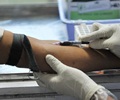
The findings, which appear in the November 29, 2013 issue of the journal Science, focus on a protein known as E2 envelope glycoprotein.
"We're excited by this development," said Ian A. Wilson, the Hansen Professor of Structural Biology at TSRI and a senior author of the new research with TSRI Assistant Professors Mansun Law and Andrew B. Ward. "It has been very hard to get a high resolution structure of E2 and it took years of painstaking work to finally accomplish that."
Any successful hepatitis C vaccine is likely to target the E2 protein. Scientists already have isolated rare antibodies from patients that can bind E2 in ways that neutralize a broad range of viral strains.
"It took our team six years to crack this very difficult scientific problem, but we didn't give up," said Law. "Now that we can visualize the structural details of these binding sites, we can design vaccine molecules that mimic them."
A Silent Killer
Advertisement
HCV was able to spread so widely because it typically causes few or no symptoms when it infects someone. In many cases it establishes a long-term infection of the liver, damaging it slowly for decades—until liver cirrhosis and/or cancer develop. "It's known as a 'silent killer'," said Law. Expensive and risky liver transplantation is often the only way to save a patient's life. Some antiviral drugs are useful in treating and even curing chronic HCV infection, but the more effective ones are extremely expensive—and most HCV-positive people don't even know that they're infected and need treatment.
Advertisement
However, like HIV and some other viruses, HCV uses several effective countermeasures to evade the immune system. These include fast-mutating regions on the E2 protein, which ensure that antibodies to one HCV strain typically are ineffective against other strains. The E2 protein also coats itself with relatively antibody-proof sugar molecules.
Source-Eurekalert














